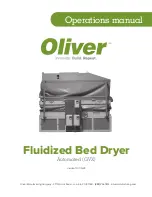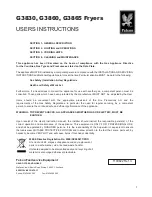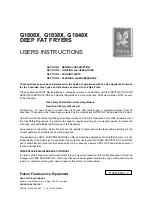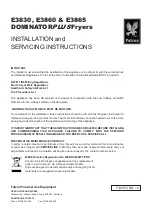
─
9
─
8. Principles of operation
Descriptions of circuit operation
(1) Notes for turning the power ON / OFF
1
When the power is turned ON, the power light (LED 1) turns on after 1.5 seconds, and the hand dryer be-
comes ready for operation.
• Before the power light turns on, the hand dryer will not operate even if hands are inserted in the hand drying
area. In the meantime, the microcomputer (IC200) on the control circuit board performs the initial settings.
2
When the power is turned OFF, the power light turns off and operation stops.
• The circuitry takes about 15 seconds to discharge the voltage retained in it. Wait until the discharging time
elapses before plugging in or out the connectors, replacing the circuit boards, or doing other maintenance.
• Even when any error is occurred, the error display will go off if the power has been turned off. Only when a
microcomputer error is occurred, the error display persists till the voltage retained in the circuitry has been
discharged (till the microcomputer has been reset).
(2) Hand detection and operation
1
A range sensor is used as the hand detection sensor.
2
When the sensor detects hands, the blower motor turns on and the hand dryer starts to operate.
3
Once operation has started, it continues as long as the sensor detects hands.
4
If delay time (*Note 1) elapses without detecting hands by the sensor, the blower motor turns off and opera-
tion stops.
Note 1: The delay time until the blower motor turns off is determined by the following setting.
<Motor delay time setting>
When the power is on, use the switch (SW3-3) on the control circuit board (JT-37MH/M) to set the
delay time to 1 or 2 seconds.
SW3-3
Delay time
OFF
1.0 s
ON
2.0 s
5
The hand dryer continuously operates for up to 30 seconds.
• Once 30 seconds have elapsed, the hand dryer stops operating even if hands are detected. (Tamper-
resistant timer)
• Since this is a function to assume the presence of a foreign object, the operation will resume when hands
are pulled out and reinserted.
(3) Control of the blower motor
1
The air speed (air volume) is determined by the switch (SW1-1 or SW2-1) setting.
SW1-1 (SW2-1)
Air speed
OFF
STANDARD
ON
HIGH
2
The motor does not start in the following occasions:
• When a temperature detected by the thermostat on the control circuit board (JT-37MH/M) is 65°C or high-
er, or lower than -40°C
• When a temperature detected by the thermostat on the power circuit board (JT-37PH/P) is 65°C or higher,
or lower than -40°C
(4) Control of the heater (Applicable models: JT-S2AP type)
1
To regulate inrush current at startup, the heater turns on 0.5 seconds later than the blower motor.
2
The heater does not turn on in the following occasions:
• When the switch (SW1-2) on the control circuit board (JT-37MH) is in the OFF position
• When a temperature detected by the thermostat on the control circuit board (JT-37MH) is 32°C or higher,
or when a temperature detected by the thermostat on the power circuit board (JT-37PH) is 55°C or higher
JT-S2AP type: SW1-1 (JT-37MH)
JT-S2A type: SW2-1 (JT-37M)










































